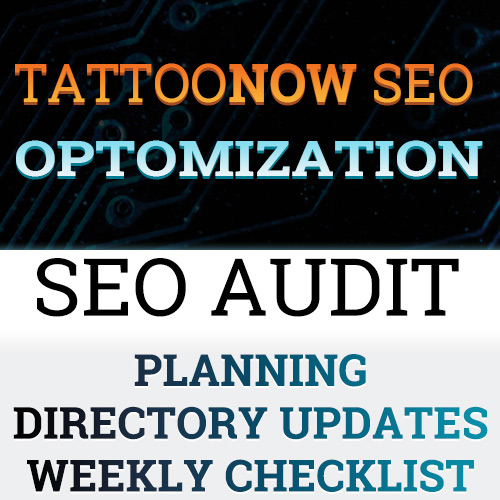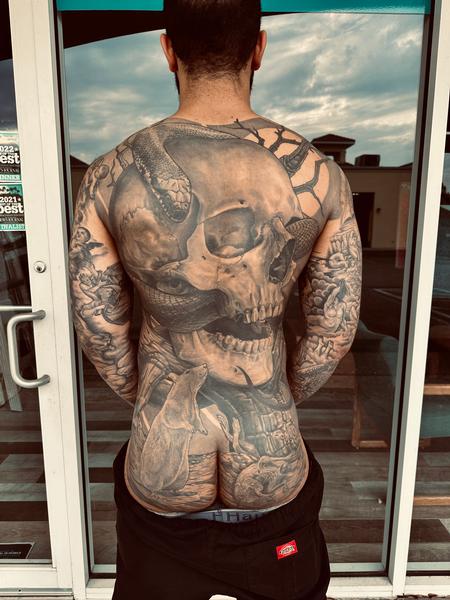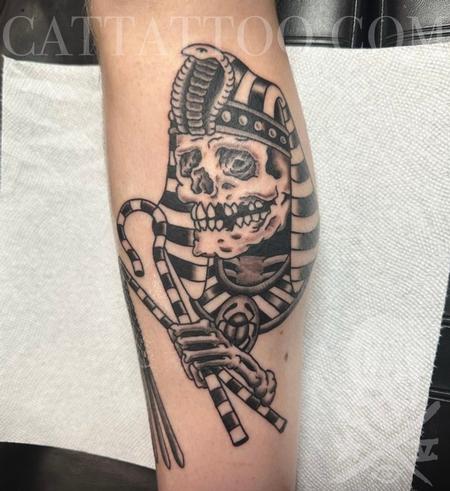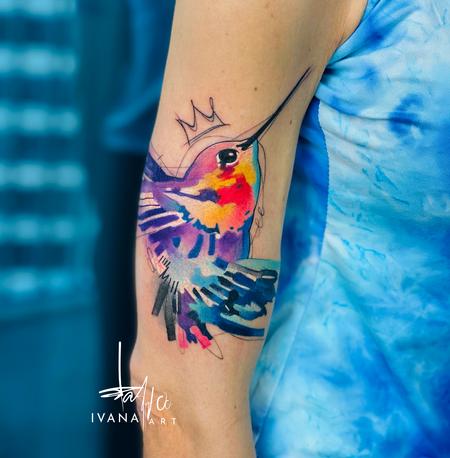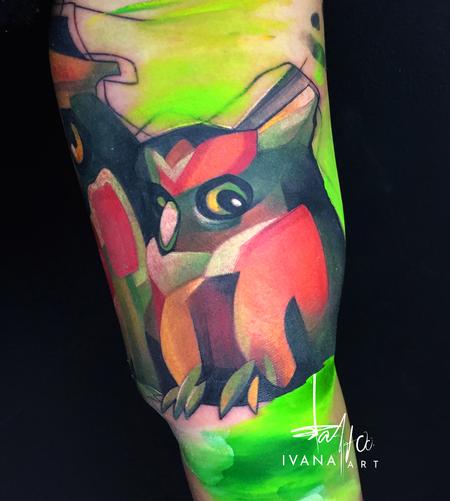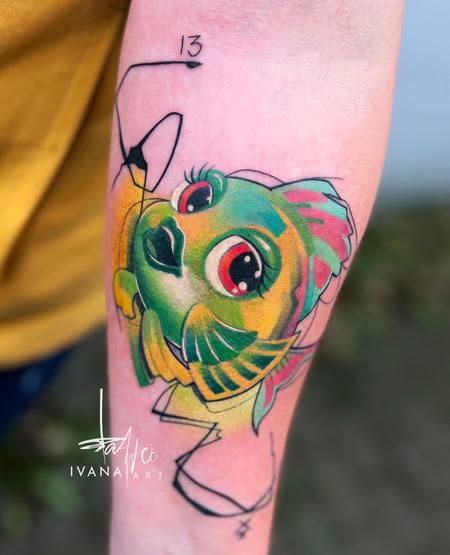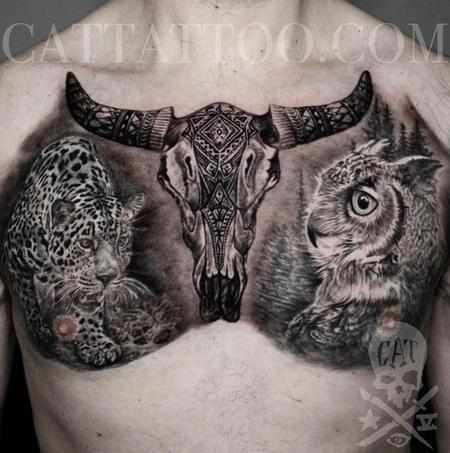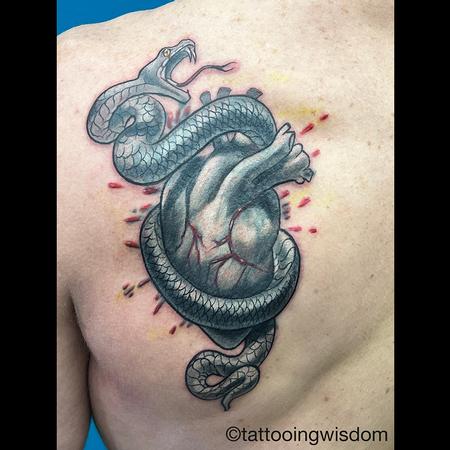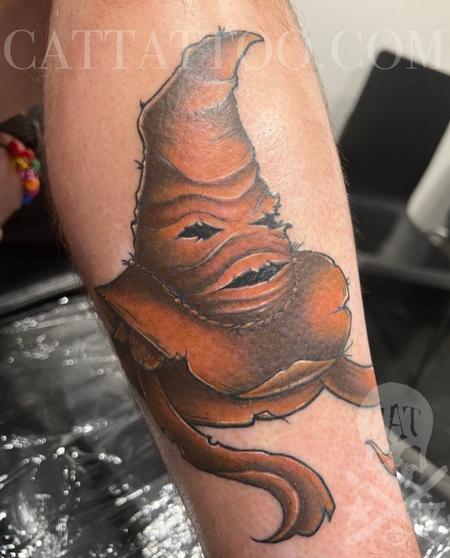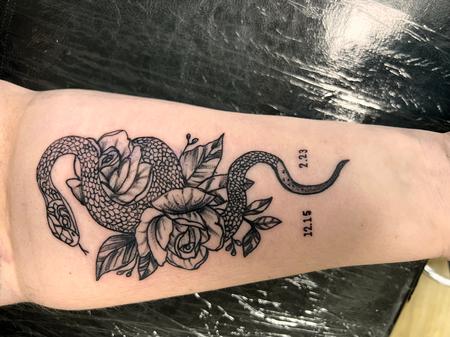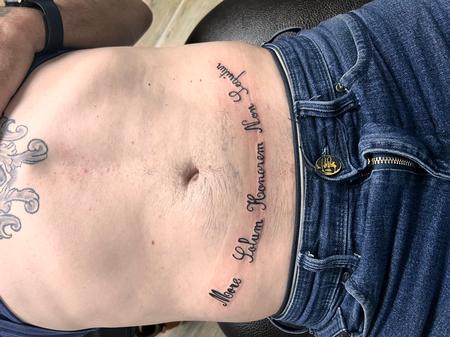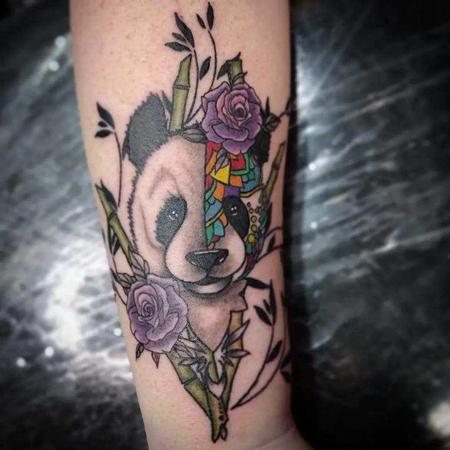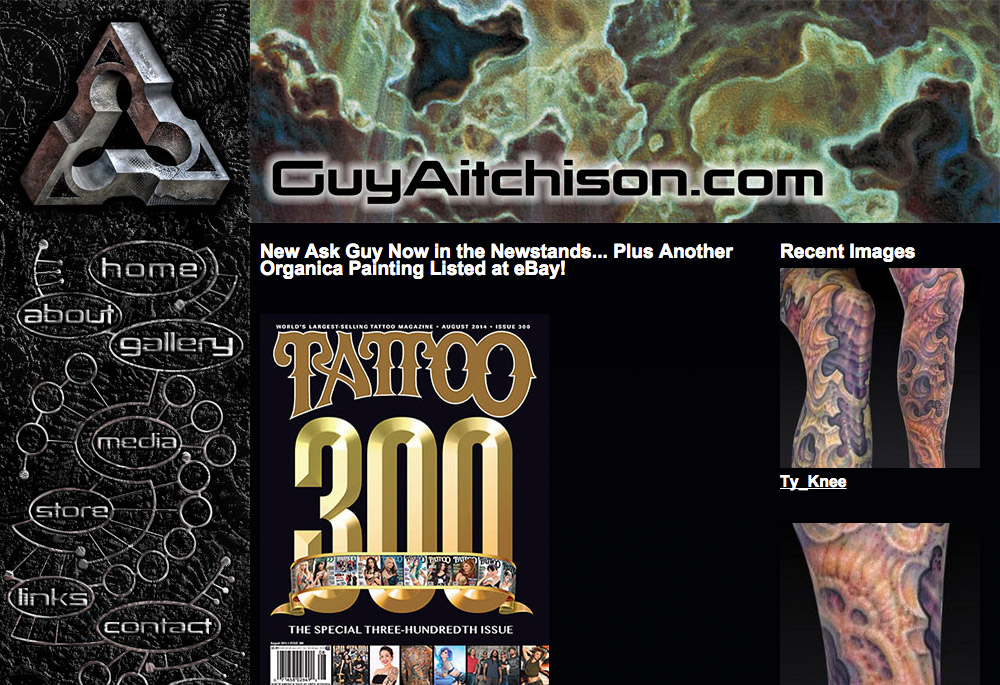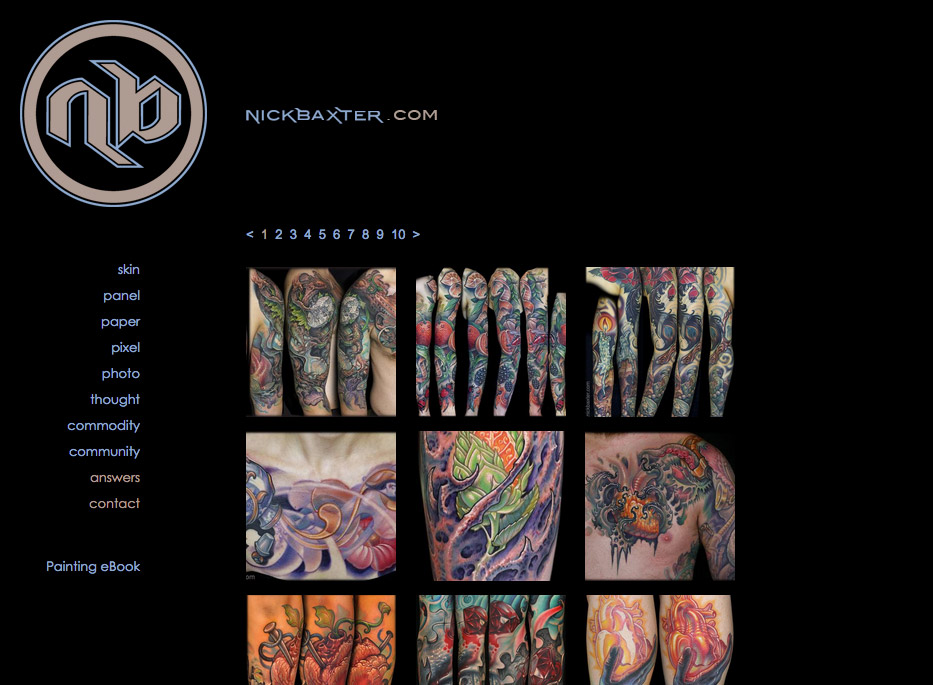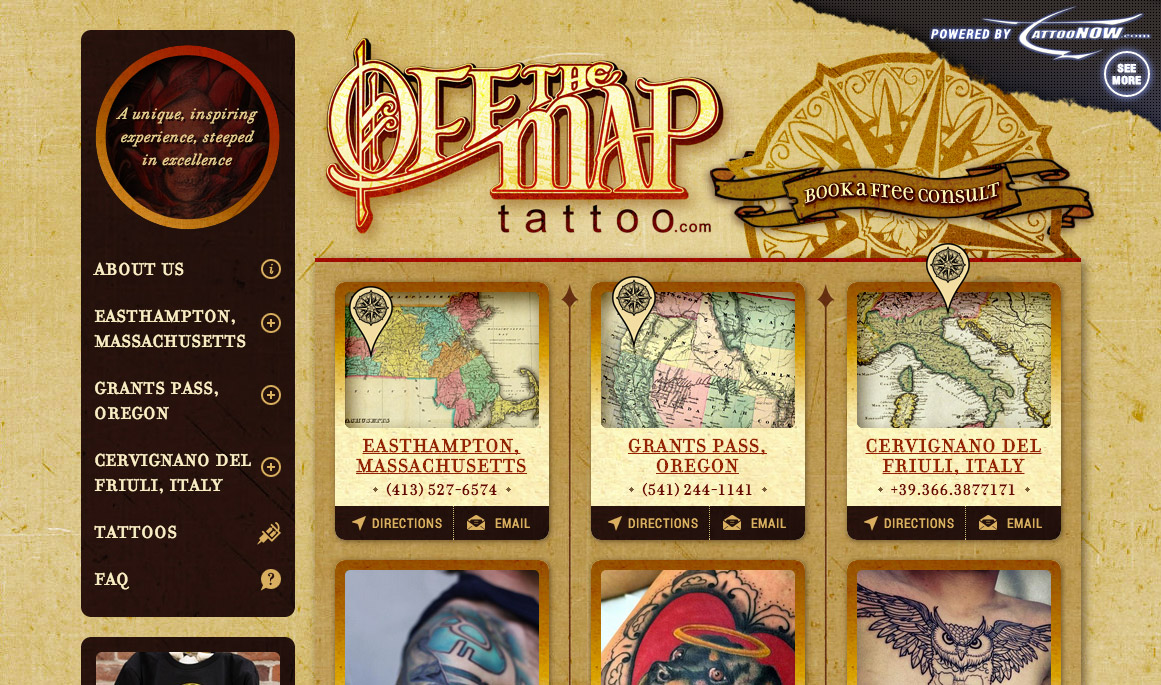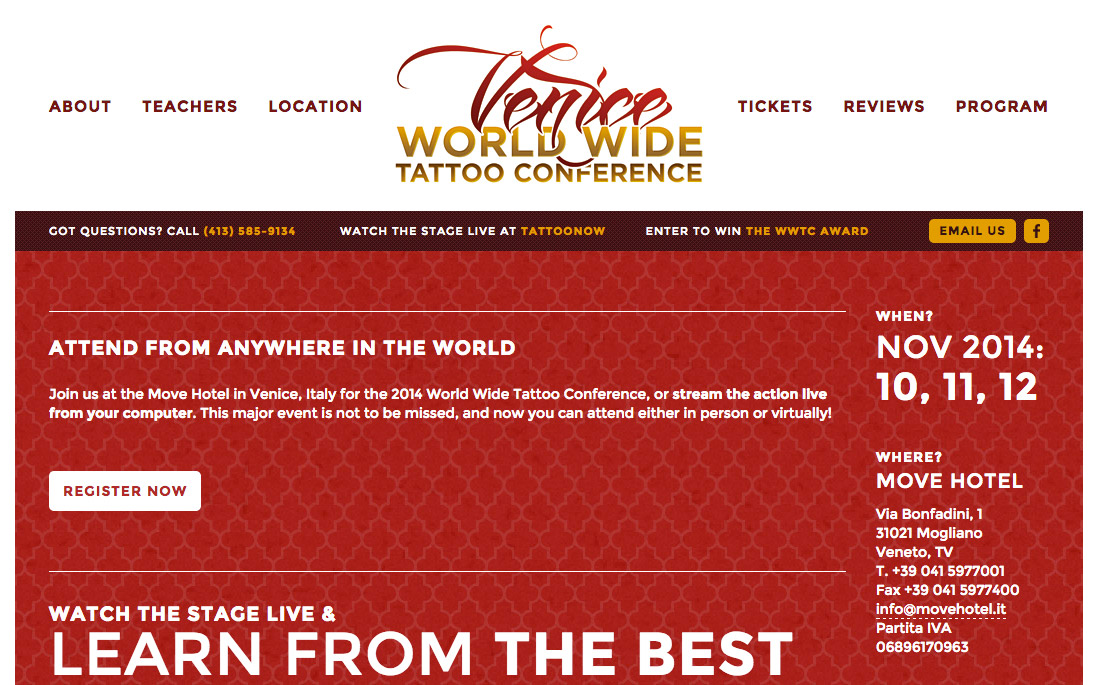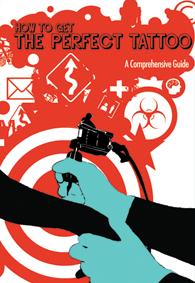Nick Baxter 2006 August
Interview with Nick Baxter by Aly E. 1. When a client approaches you for work, what do you typically look for in their ideas that can serve as a basis of the piece you will ultimately design?
I try to look for the essence of what they are explaining to me…the feeling and the mood and the meaning behind all the words they are using. If I can get into their head that way, If I can understand where they are coming from rather than ‘merely waiting for my turn to speak’ then the artwork will usually develop from there in a natural, intuitive fashion, with mutually agreeable results. This part of the process has little or nothing to do with art or tattooing and everything to do with human relations and communication skills.
 2. What other art forms inform your unique tattooing style?
2. What other art forms inform your unique tattooing style?
The most prominent forms are photography and painting. Then there’s life drawing, and graphic design.
3. What do you find most challenging and most rewarding about tattooing?
Working within the limitations of the human body and the organ of skin is perhaps the most challenging aspect…considering all aspects of the surface you’re affecting, such as healing and longevity. Ironically, the human aspect of tattooing is also the most rewarding…the fact that you can aid someone in their personal transformation and adorn their body with something permanent and meaningful.
4. Can you cite an example of a piece you’ve begun or completed recently that illustrates this personal transformation?
Some pieces from my website’s tattoo gallery that illustrate this are “Beauty of Nature,” “Ghost Orchid,” “Shell Heart Memorial,” and “A Brave New World.” All of these pieces were very important and symbolic to their collectors, and they entrusted me with representing and interpreting these bits of personal transformation for them, and that was very flattering and inspiring to be able to do for someone. Not that every tattoo has to be an experience like that, but it helps you appreciate things in life a little more when it does happen.

5. In what ways do you keep your work new and exciting?
Firstly, I try not to repeat specific ideas or images too often. For example, the pixilated tattoos that I started doing but ultimately felt I had to stop because too many people were asking for the same ideas over and over again, causing it to feel stale and monotonous for me. Secondly, I try not to overwork myself; absence makes the heart grow fonder, so to speak, and can breathe new creative energy into a sometimes stifling routine. Thirdly, I try to look as far outside my work as possible for inspiration, ideas and energy. Tattooing especially (perhaps because of its unique, though diminishing, outsider/lowbrow status) can be a far too self-referential, closed off art form, which leads to artistic progress being suffocated. It seems very cannibalistic at times.
6. Can you give me an example or two of something you have recently found inspirational in an unexpected place?
There are little quiet inspirations constantly, everywhere, every day of life, if you can get into the right frame of mind to appreciate them. One of them recently for me I think, was finding a newfound appreciation in the Yale Art Gallery for all these early American portraits and Revolutionary War battle scenes they have there. Those things are something I’ve typically only glanced at disinterestedly, but the other day I was struck by the thought of the artists themselves, rather than simply the finished product hanging on the wall in front of me. Did these artists sit and paint in the middle of a battle scene? Did they go out and fight by day and then record their experiences on canvas by night? Did they have models posing in their studios for them, acting out their deaths? I just tried to imagine what it must have been like to be these artists. It certainly wasn’t as easy or convenient as we artists have it these days, not by a long shot. That was inspiring to me, to then look at what they created out of that madness with a slightly different perspective. It felt so much more epic and important. I want my artwork to feel like that to someone, somewhere, someday, if only…
7. With commercialization and mass media that defines our society, what is the role of original art in social awareness?
Art contains the potential to spark someone’s emotions and passions in extremely unique and powerful ways…much more so than dry, factual, political essays for example. The human act of expressing oneself through images or song or what have you is a timeless, universal, and very primal urge, and in being so can affect peoples’ very core or essence, thus heightening or otherwise altering their awareness or perception of what’s around them. Whether it be the creator of the works or the viewer of them, this affect is the same.
8. How does this translate into tattoos? Is there an added level of perception that comes from the choice not to simply create or view, but to wear as an expression of self permanently?
For some people, yes—and the potential that unlocks can be great—but for others, or even most, I’d say probably not. Which for better or for worse, is merely a result of our consumerist culture which reduces everything into a quantifiable physical form and strips away whenever possible all connectedness and meaning—or at the very least, dumbing it down to fit the lowest common denominator of basic thought. So naturally, this happens with tattoos like anything else. Many people see them as another possession to acquire, to shop for and consume—an accessory to a lifestyle and an image. Which is not necessarily a judgment for or against anyone in particular, just a critique. Whatever works for you, then do it…but just try not to sell yourself short.
9. What does the nature/technology theme you’ve explored in some of your pieces mean to you, and what do you see it evolving into next?
This theme is really just a microcosm of the larger duality being played out right now in the world around us…this battle we have going on (whether one chooses to pay attention to it or not) between capitalism and freedom, people and institutions of power, greed and sharing, development and sustainability, control and chaos. I suppose it’s become prevalent in some of my tattoo work especially because it lends itself to attractive, interesting juxtapositions of easily identifiable subject matter, which makes for good tattoos. As for where it goes from here…I haven’t thought much about that, at least as far as the tattoos I do are concerned. They are usually some sort of collaboration or combination of mine and the client’s minds, so in large part it will be determined by my clientele…

10. Some of your images have several (if not many) levels upon which they could be interpreted. Is symbolism necessary for a tattoo to be effective, or is “it looks cool” good enough?
Every single tattoo or piece of artwork ever created has symbolism or meaning outside of itself, whether intended as such by the artist or client or not—I truly believe that. A visual representation of something (even an abstract image) is created by a human being with both a conscious and subconscious mind. So even if the conscious mind tells itself or the outside world that there is no meaning involved besides looks, the subconscious mind has a motivation and a reason for this and for what imagery was chosen, the style it was produced in, and so on. This is what I would refer to as ‘symbolism’ or ‘meaning.’ It’s simply unavoidable.
11.That’s interesting, even when the client says there’s no meaning, his or her choice, is on a deeper level, still symbolic. Is it then important to challenge clients to think outside the norms of expression when discussing a tattoo design i.e. to step outside the visual language of our popular culture to find new, creative ways to express common themes?
I’ve always felt that it is important to do this, of utmost importance really. My most inspired and best tattoos are usually the ones where the client has put enough creative thought into their idea to then spur my own creative process further when proposing it to me. Or similarly, when I’ve been able to draw something more unique or creative or profound out of them during a consultation process. Alternately, when you’re not working with much, it can be hard to give back much. Basically you get out of it what you put into it, in most cases. But everything has its place…sometimes people may want a very common image or motif simply because of the fact that it connects them to a tradition or to a larger group of humanity, it gives them a sense of familiar comfort and belonging they are subconsciously after. In certain cases, there’s nothing wrong with that. In other cases, maybe it should be discouraged.
12. What aspects of a tattoo make a piece powerful to you I.E. on a given piece, how do you determine the focal points and flow?
Really, it could be any great number of things, certainly not limited to focal point nor flow. There are many different ways that something could register in my brain or trigger my subconscious. My powerful left brain always wants it to be technically and flawlessly executed though…that is possibly the only constant criteria, although I’m sure I could think of exceptions to it.
13. I see that same drive for perfection in much of your work on your site. Does that amazing attention to detail translate into other parts of your life?
For better and unfortunately for worse, yes it does translate to everything. Naturally being this way has led me to achieve some really great things in my life. But then, I have a tendency to drive people nuts in my obsessive compulsions, and I can be way too hard on myself in everything I do. Whether it’s in relationships or anything else, I construct perfectionist ideals and beat myself up for not achieving them. I’m trying to find a healthy balance. I don’t ever want to be content and complacent though, especially with my art.
 14. Several pieces on your site are collaborative efforts with various artists, such as Carson Hill, Lou Jacque, and Adrian Dominic. What are the unique payoffs and challenges that come up in the process of working collaboratively?
14. Several pieces on your site are collaborative efforts with various artists, such as Carson Hill, Lou Jacque, and Adrian Dominic. What are the unique payoffs and challenges that come up in the process of working collaboratively?
Combining two different minds and techniques into one temporary mind and a resulting finished product is both the payoff and the challenge. Basically, it’s the process of communication, compromise, and sharing in what we often get very comfortable in always doing solo.
15. Does your technique become more refined by working with other artists as well; different styles working in collaboration to produce new innovations? If so, can you give an example?
Yeah that’s one of the best things about collaborating, is seeing how someone else does things and having that refine your own technique, either by experiencing what’s problematic about what someone else does or how it’s better than what you were doing before…and vice versa. I’ve started using new equipment, materials, and approaching pieces differently because of working with other artists.
16. Your paintings have a haunting, evocative quality to them. Can you talk a little bit about the inspiration and thread behind “The End Of An Era” and what drove you to do the series?
The End Of An Era series came from my desire for and fascination with catastrophic upheaval and transformation, on microcosmic and macrocosmic levels. Some of those pieces are about reality-altering personal changes I have both been through already and desire to go through. Others deal with catastrophic changes I see in the world around me such as environmental destruction and manipulation of peoples’ minds via religion or mass media. The series is a recognition and a public confession of sorts, of this feeling I’ve had my whole life of impending doom, which I’m sure is very related to my problems with depression. But it also has tangible external causes, like if you bother to research things enough and piece the historical puzzle together, it would be very hard not to draw the conclusion that our civilization is at the end of an era of relative wealth and comfort and unsustainable growth, and it’s all about to come crashing down sometime in the next few hundred years I’d predict. Due to nuclear war or disease—or most likely vast climate change due to global warming, which is actually an undeniable, scientifically proven (and by now, consensus) fact. Or maybe I just like to be an alarmist because I want to experience change so badly…I’d love to shock everyone into action, to change things for the better, if I could.
17. I think your work and your willingness to talk about these things definitely affects change. There are many parallels between the path our country is currently on, and the fall of the Roman Empire. It seems unlikely that we’d be able to turn it around, but if it’s at all possible, what role do you see the individual taking in changing the path we’re currently walking down?
I think on an individual level, what needs to happen is mainly mental and emotional. Answering this question to the fullest extent which it should be answered could be its own book, but I will attempt to summarize my own perception of the matter. Basically, I think the biggest role individuals can take in changing our current path is to unlearn several key lessons we are taught throughout our lives, like the myth of individualism, the myth of scarcity, the myth that the external can fix the internal, and the myth of hierarchy, power and domination being necessary for human survival and happiness. We all have such a learned helplessness, a fear of ‘what’s out there’ that someone else is always expected to take care of for us…these few myths I’ve listed all contribute to this mental state that casts the illusion of every man for himself and each against the other. So anyways, aside from acting en masse in an armed, violent revolution of people versus power (meaning governments and corporations), I think the only other possible way for real change to occur to alter our doomed path is mental, on a personal level. Every single person needs to deconstruct himself or herself and piece themselves back together in ways that are more conducive to sustaining healthy happy lives of reaching our fullest potentials. The hard part is that it’s often a lifelong project full of mistakes along the way, but that is no excuse for not having the guts to attempt it.


18. I think some readers might be surprised to see some of the pieces in person; some are quite small, and the level of detail you are able to capture is truly amazing. Can you describe your painting process a little, and does it lend itself to tattooing?
I only started painting so small as a way to be sure I finished everything I started, before I got too busy with other things or got discouraged if a portion wasn’t working out the way I hoped. However, this also seemed to mesh well with my mind’s natural tendency toward minutia and macro detail, so as a result I now have a decent body of work that is pretty small in physical size. Lately I have been trying to paint bigger and be more ambitious in order to keep growing as an artist. My painting process involves many semi-translucent layers of paint (glazing and scumbling), to build up subtle effects and detail. It’s an empirical, holistic approach of gradual metamorphosis as opposed to a more cut and dry ‘one shot, one kill’ way of doing things. Luckily these techniques have more or less translated to tattooing for me, or at the very least have influenced my tattooing technique, though they are certainly not completely equivalent mediums.
19. From what I have seen, much of your tattoo work is cumulative in that way, multiple appointments, layering, etc. Do you see that as a must, or do you occasionally do a one stop shot?
I can work either way. Naturally each way is slightly different from the other. Layering things over different sessions opens up way more artistic possibilities not limited to what the skin can only handle at one time. Usually my best tattoos are the ones I get to do more of a painterly process of layering with, but I realize that is sometimes a luxury that can not be afforded either monetarily or in other ways.
20. Many artists go through phases with mediums, moving from graphite to oils, etc. In surfing your site, I noticed that you seem to work in multiple mediums concurrently. Does working across mediums inform your artistic process?
Yes, very much so. Usually, however, I go through mini-phases where I’ll get really into painting for a few months, then need a break and get really into photography for a bit, etc. I guess they all kind of fuel each other in that way. But I guess the point you were making was that I have not abandoned any of the art forms in favor of another. For whatever reason, I have never felt the need to do that thus far in my life, perhaps for the same reasons that I absolutely hate not finishing a painting or tattoo or other project I’m working on…I see that as some sort of bad karma or energy, to not follow through with things in life and allow yourself the satisfaction of completion, regardless of how imperfect the final product may seem or how sharp 20/20 hindsight may be.
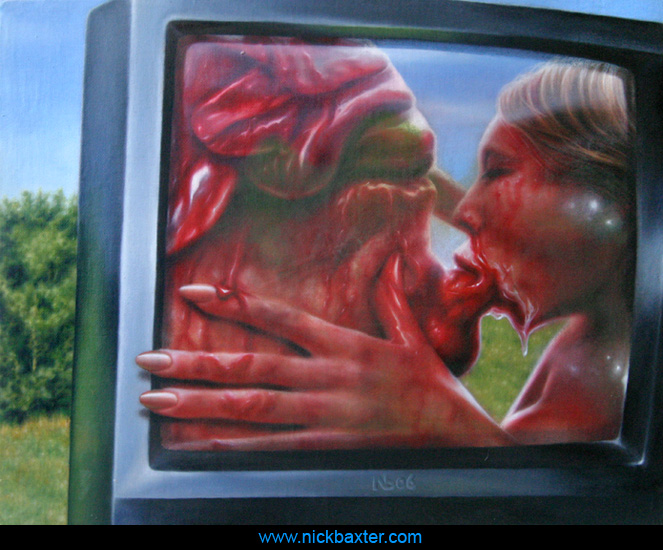
20. Are there any new projects on your horizon that you’re particularly excited about undertaking?
Yes! As always, I have many plans that need to be actualized…right now I think I have a new painting series brewing somewhere inside me, if I can ever get it to come to fruition. And I’m going to be working on some non-art or tattoo related writing projects soon. And I just finished what I feel is a really epic looking ‘flash’ set done collaboratively with friend and fellow tattoo artist Jeff Ensminger, which should be available to the public soon (Aug.-Sept. 06).
21. Can you give us a little tease of what we can expect for the writing projects, and maybe if there’s a theme to the flash set you mentioned?
I don’t want to jinx myself with the writing project, it’s going to be a lot of work. But the flash set deals loosely with a theme of life and death/growth and decay. It’s not anything too deep or involved.
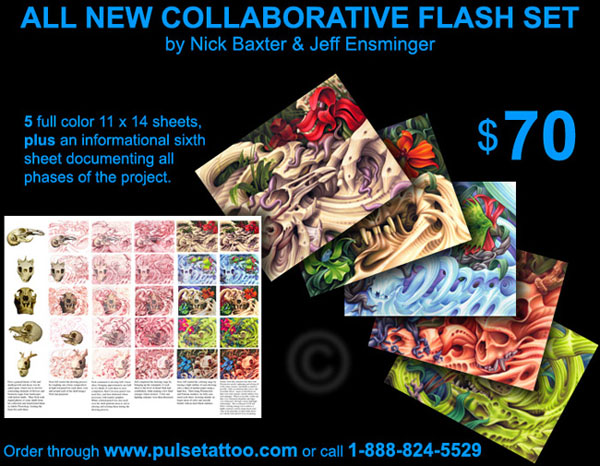
22. I also took the time to read through your writing, very moving, and thought provoking essays. I have a lot of admiration for someone who uses his relative success to inform and uplift in the way that you have. Can you tell me a bit about ways in which you are using your art and voice to make a difference in the world and why that is important to you?
I’m just trying to not take what I have for granted—which is honestly hard, living in this land of hedonistic excess and distracting vice. I’m trying to appreciate every day how fortunate I am to have found something I’m good at while simultaneously being recognized for it and given a public forum in which to express it. So that means whenever or wherever I have the opportunity to speak or write to an audience, be it an interview or my website, I’m going to try to include something that relates to enriching the lives of all humans and/or improving the quality of experience of all life forms on this Earth. I guess maybe because despite whatever horrible external conditions we exist in, I have a belief in a core human goodness…that life, liberty, happiness is in the end, preferred by all creatures over death, oppression, suffering. In addition to ‘speaking out’ via mass media I donate my art, time, energy, and sometimes money to a variety of causes and struggles for the above stated three goals. Stuff like animal rights groups, protests and other forms of activism and direct action. And finally, I think the most overlooked and hardest thing to do, which I’m always working on, is to just be a compassionate, honest, and completely generous person in your every day, person-to-person existence. It’s easier nowadays to get lost in a sea of abstractions and great noble causes and institutions and organizations, than it is to walk up to your neighbor or co-worker and offer them a ride somewhere or a free meal or a shoulder to cry on in a time of need. So many times we mistreat our loved ones and those closest to us every day, all the while preaching about saving the world and everyone we’ve never even met. This is what bothers me the most about myself I think, this is how I’d like to make more of a difference in my little corner of the world.
23. Are there any worthwhile projects that you’d like to mention that you’ve supported with your time, art, etc?
I’ve done all kinds of different projects solo and with others under the moniker “CrimethInc.” which is essentially just a decentralized group of people who tend to be ‘anarchist’ in their philosophies and ways of doing things. Anyone can claim the term CrimethInc. for themselves or their work, or a particular project, if it applies. It’s an idea more so than anything else…although a lot of people resent it because they see it as an elitist activist clique. I personally only care about the ideas behind it, which I feel are very sound and useful, so I don’t have a problem associating myself with it. Anyone can check it out at www.crimethinc.com
Right now I’m trying to help out whenever I can with a local project here in New Haven CT called the Elm City Infoshop. Anyone can check that out too at www.elmcityinfoshop.org
Also just check out the links page of my website, under ‘Community.’ There are a bunch of related links there, some of which I have been involved with. 

